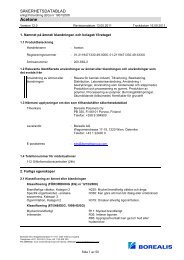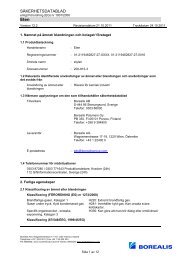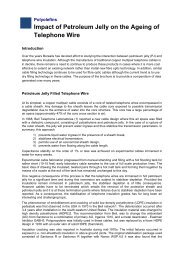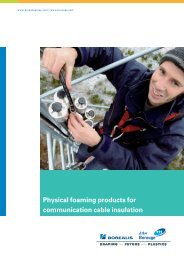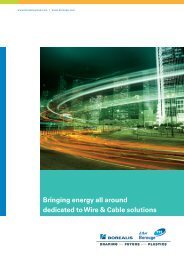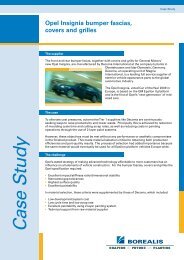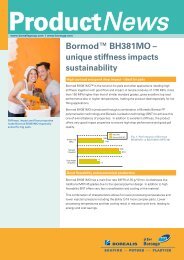Polyolefins Moulding Thin Wall Packaging - Borealis
Polyolefins Moulding Thin Wall Packaging - Borealis
Polyolefins Moulding Thin Wall Packaging - Borealis
You also want an ePaper? Increase the reach of your titles
YUMPU automatically turns print PDFs into web optimized ePapers that Google loves.
www.borealisgroup.com I www.borouge.com<br />
<strong>Polyolefins</strong> <strong>Moulding</strong><br />
<strong>Thin</strong> <strong>Wall</strong> <strong>Packaging</strong>
www.borealisgroup.com I www.borouge.com<br />
About <strong>Borealis</strong> and Borouge<br />
<strong>Borealis</strong> and Borouge are leading providers of innovative, value creating<br />
plastics solutions. With more than 40 years of experience in polyolefins<br />
and using our unique Borstar ® technology, we focus on the infrastructure,<br />
automotive and advanced packaging markets across Europe, the Middle<br />
East and Asia. Our production facilities, innovation centres and service<br />
centres work with customers in more than 170 countries to provide<br />
materials that make an essential contribution to society and sustainable<br />
development. We are committed to the principles of Responsible Care ®<br />
and to leading the way in ‘Shaping the Future with Plastics’.<br />
<strong>Borealis</strong> is owned 64 % by the International Petroleum Investment<br />
Company (IPIC) of Abu Dhabi and 36 % by OMV, the Austrian oil and<br />
natural gas group. With EUR 5.7 billion revenue in sales in 2006 and<br />
4,500 employees, the company is headquartered in Vienna and has<br />
manufacturing operations in Austria, Brazil, Belgium, Finland, Germany,<br />
Italy, Sweden and the United States. <strong>Borealis</strong> also has two innovation<br />
centres and customer service centres across Europe.<br />
The company’s main products are polyolefins and it produces also nutrients<br />
and base chemicals such as melamine, hydrocarbons, phenol and acetone.<br />
Borouge is a joint venture established in 1998 between <strong>Borealis</strong> and one<br />
of the world’s leading oil companies, the Abu Dhabi National Oil Company<br />
(ADNOC). Its headquarters, counting 830 employees, and its state-of-the-art<br />
world-scale petrochemical complex are located respectively in Abu Dhabi<br />
and Ruwais, the United Arab Emirates. Borouge is currently implementing<br />
a multi-billion dollar expansion at its<br />
Ruwais production facility. The project,<br />
called Borouge2, is due for completion<br />
in 2010 and will triple the company’s<br />
polyolefin production capacity.<br />
For more information:<br />
www.borealisgroup.com<br />
www.borouge.com
Contents<br />
02 Market introduction<br />
03 <strong>Thin</strong> wall packaging<br />
07 Creating new concepts and adding value<br />
for the stakeholders<br />
08 Technology that delivers desired benefits<br />
09 Controlled crystallinity leads to uniform shrinkage<br />
10 Product development – a key factor for success<br />
13 Tailormade products<br />
15 Bormod BJ368MO strengthens polypropylene<br />
capabilities for consumer packaging<br />
15 Bormod BH348MO – the high flow, high impact<br />
solution for deep freeze applications<br />
01
02<br />
<strong>Polyolefins</strong> <strong>Moulding</strong> – <strong>Thin</strong> <strong>Wall</strong> <strong>Packaging</strong><br />
Figure 1: Injection moulded TWC’s represent<br />
30 % of the injection moulded PP in Europe<br />
Market introduction<br />
Over 30 % of the world polypropylene consumption is used in packaging<br />
applications. In rigid packaging, the European polypropylene consumption<br />
is growing at more than 3 % per year. This makes polypropylene one of the<br />
most communly used polymers amongst those used in this segment. The<br />
Western European Market is segmented as shown below and the strong<br />
growth is expected across most segments.<br />
Polyethylene has for many applications been replaced by polypropylene,<br />
but is still an important material for some thin wall packaging segments like<br />
soft lid applications.
<strong>Thin</strong> wall packaging<br />
<strong>Borealis</strong> is a leading polyolefins supplier to the <strong>Thin</strong> <strong>Wall</strong> <strong>Packaging</strong> segment.<br />
We view this market as strategically important and show our commitment by<br />
supplying materials for both consumer and industrial applications which keep<br />
pace with the latest trends and fulfil the needs of the whole supply chain.<br />
A long-term commitment to thin wall packaging<br />
For many years <strong>Borealis</strong> has been a very active partner in polyolefins for thin<br />
wall packaging. <strong>Borealis</strong> was an early innovator in the market with tailormade<br />
grades for pails and consumer packaging and today offers a complete product<br />
portfolio for this segment. All grades contain optimised additive formulations,<br />
such as antistatics and nucleators, and are often co-developed together<br />
with several stakeholders in the value chain (resin suppliers, converters,<br />
specifiers). In polypropylene for transparent packaging, <strong>Borealis</strong> also made<br />
an early breakthrough with grades specially tailored to replace glass in<br />
consumer packaging.<br />
A growing preference for PP<br />
Nearly 35 % of all polypropylene converted in the rigid packaging segment is<br />
used to produce thin wall containers, and PP is expected to further strengthen<br />
its position in this segment at the expense of both glass and metal. With<br />
benefits such as low density, high impact, transparency and easy injection<br />
moulding operation, the growing preference for polypropylene in this segment<br />
is easy to understand. New PP grades that combine improved properties and<br />
high flow make progressive down-gauging possible to further reduce weight,<br />
but also create new design possibilities. This has significantly changed the<br />
competitiveness of injection moulding versus thermoforming.<br />
Food Non-food<br />
Industrial Confectionery & bakery Building materials & equipment<br />
Hotel & catering Industrial consumables<br />
Pre-products Chemicals & paints<br />
Dairy & yellow fat Adhesives<br />
Consumer Convenience food Household chemicals<br />
Confectionery & bakery Cosmetics<br />
Frozen food & ice cream Digital media<br />
Dairy & yellow fat<br />
Everyday commodities<br />
Fruit, spices, sea food & pet food<br />
Electronics & DIY (Do It Yourself stores)<br />
Table 1: <strong>Thin</strong> wall packaging<br />
03
04<br />
<strong>Polyolefins</strong> <strong>Moulding</strong> – <strong>Thin</strong> <strong>Wall</strong> <strong>Packaging</strong><br />
Figure 2: The market<br />
Source:<br />
(1) Pira 2004 report on <strong>Thin</strong> <strong>Wall</strong> Consumer<br />
(2) AMI 2006 <strong>Thin</strong> <strong>Wall</strong> <strong>Packaging</strong> Europe<br />
(3) Townsend 2006 PP consumption<br />
(4) Warsaw voice:<br />
http://www.warsawvoice.pl/view/15031<br />
Additional drivers of Injection Moulded PP growth<br />
• Growing demand for convenience food packaging<br />
•<br />
•<br />
Growing demand for premium packaging using IM-IML combined with<br />
superior finishing characteristics and design features<br />
Cost competitiveness vs PS<br />
Environmental advantages<br />
From an environmental viewpoint, the value of thin wall injection moulded<br />
polypropylene as a single material solution is increasingly recognised. The<br />
material can be used for pot, lid and label, offering intuitive environmental<br />
advantages compared to glass with metal lid, plastic coated cardboard or<br />
PP with a PE lid. As with polyethylene, polypropylene only needs very low<br />
concentrations of additives and all <strong>Borealis</strong> grades are approved for food<br />
applications.<br />
The market<br />
Pira estimates that nearly 29 bn <strong>Thin</strong> <strong>Wall</strong> Containers (TWC’s) were used<br />
in Western Europe in 2004, which translates into some 800,000 tonnes of<br />
PP resin (1) . TWC’s for Consumer food is the largest end-use application,<br />
accounting for just over 70 % of the total volume, the rest being split between<br />
TWC’s for consumer non-food and industrial food & non-food. In Western<br />
Europe, Germany is the largest market for TWC’s and this Western European<br />
market for TWC’s will continue growing around 2.7 % p.a. till 2010 according<br />
to the AMI 2006 report.<br />
In the meanwhile, Eastern European consumption reached an estimated<br />
120,000 tonnes of PP, with Poland accounting for approximately 15 % of this<br />
volume. The average Eastern European growth rate till 2010 is around 8.0 %<br />
p.a., with 10 % p.a. in Russia and 6.1 % for Poland (3) . If Germany is the single<br />
largest market for TWP, Poland is probably the most dynamic. Indeed, in 2007<br />
domestic product grew by a whopping 7.4 percent and its GDP was around<br />
6.1 % in 2006 (4) . The EU accession in May 2004 has stimulated consumer<br />
goods production, especially food, which without customs duties can now be<br />
competitively exported to the West. Even if the economy is supposed to<br />
slow done to 5 % in the coming years (4) the Polish consumers remain<br />
more open to new packaging solutions such as jams or mustard in TWP<br />
which offer better price and functionality (lighter shopping, less likelihood<br />
of breakage), while the conservative German, French or British consumer<br />
will typically prefer traditional glass jars for jam or mustard, making Poland<br />
count as an important future TWC market.
<strong>Packaging</strong> and consumer trends<br />
The main growth drivers for the TWC market are:<br />
•<br />
•<br />
•<br />
•<br />
•<br />
Consumers are purchasing more pre-packed foodstuffs, including<br />
products in TWC’s<br />
Consumers show increasing preference for chilled foodstuffs and tend<br />
to opt for a chilled soup in a TWC rather than a retorted tinned soup<br />
Consumers are looking for lighter and more shatter-resistant packs<br />
which include convenience features such as microwaveability and<br />
added value items such as sporks (a combination of spoon and<br />
fork), so TWC’s are a perfect match for their needs<br />
Brand owners are increasingly competing with own labels and<br />
select in-mould labelled TWC’s to differentiate their products and<br />
add a premium look<br />
The retailing and catering sectors prefer TWC as they offer better<br />
sturdiness and stackability when compared to thermoformed<br />
containers<br />
Important features to strengthen the trend<br />
In-mould labelling is a cost-effective form of TWC decoration for consumers<br />
where a premium look is combined with a moisture and grease-proof<br />
labelling solution. In recent years, legal labelling requirements have become<br />
an additional factor, making food producers switch from off-set printing to in<br />
mould labelling as the latter can cope much better with the increased amount<br />
of information which needs to be put on products such as margarine tubs.<br />
Product visibility is much appreciated by the consumer who likes to check<br />
foodstuff freshness or see the colour of the paint. This increases the demand<br />
for transparent PP grades which show above-average growth rates and now<br />
account for the majority of use.<br />
Tamper evidence TWC’s, especially in-mould labelled TWC’s, offer premium<br />
looks and tamper evidence. Brand owners very often select them for new<br />
product launches. Built-in tamper evident solutions avoiding welding and<br />
adhesion of foil are a competitive advantage of TWC.<br />
05
Creating new concepts and adding value<br />
for the stakeholders<br />
Partner for growing value<br />
BU moulding has selected to serve the industry with a partner approach.<br />
As a partner <strong>Borealis</strong> has a strong market approach and puts major efforts<br />
into identifying the real needs in the value chain. This approach ensures the<br />
best synergies of polymer properties, article design and end-use needs to<br />
create value for the stakeholders in the value chain. <strong>Borealis</strong> also believes this<br />
approach increases the speed of new development in polyolefins, as a shared<br />
value chain understanding ensures that all product requirements are identified<br />
in the early phases of development.<br />
To support this thinking even further, projects with research institutes and<br />
universities, as well as cooperation with our suppliers, are part of <strong>Borealis</strong>’<br />
daily life.<br />
Partnership through the value chain<br />
Feed stock Olefins <strong>Polyolefins</strong> Converters End-users Consumers<br />
Polypropylene for industrial containers is present and future<br />
Pail grade development has been an important task for <strong>Borealis</strong> for many<br />
years. Through joint projects with our partners we have developed tailormade<br />
grades for industrial containers and not only offered faster processing<br />
solutions, but also successfully replaced tinplate containers. Recently <strong>Borealis</strong><br />
has supplied transparent polypropylenes with high impact to the paint and<br />
pail industry. By close cooperation with specifiers also new high flow PP<br />
copolymers offering new design opportunities of even 5 and 10 liter pails are<br />
introduced. This strenghtens the position of PP versus metal as the material<br />
choice even further.<br />
Higher<br />
growth<br />
Figure 3: Value creation path<br />
–<br />
Enhanced<br />
profits<br />
07
08<br />
<strong>Polyolefins</strong> <strong>Moulding</strong> – <strong>Thin</strong> <strong>Wall</strong> <strong>Packaging</strong><br />
Consumer packaging for the future<br />
Challenging targets have been set by the food industry for packaging concepts<br />
for products like margarine and ice cream. By putting high focus on taste<br />
& odour and food packaging regulations in combination with requirements<br />
for packaging processing and packaging physical performance, <strong>Borealis</strong> has<br />
successfully participated in the introduction of low weight margarine tubs, as<br />
well as injection moulded transparent ice cream packaging. The outcome has<br />
been the replacement of cardboard or thermoformed packaging.<br />
Technology that delivers desired benefits<br />
<strong>Borealis</strong> disposes of a range of competitive technologies that afford to<br />
translate application requirements into specifically designed polymer<br />
products. Notably, <strong>Borealis</strong> proprietary Borstar process is particularly qualified<br />
to tailor the molecular architecture of both PP and PE, thus combining both<br />
application processability and excellent mechanical properties. Borstar uses<br />
a multi-reactor system that offers unparalleled possibilities when designing<br />
polyolefins for specific applications.<br />
Borstar PP<br />
The first commercial plant went on stream in May 2000 in Austria. It produces<br />
a wide range of added value polymers that are recognised by customers to be<br />
at the cutting edge of modern PP technology.<br />
The unique process configuration and the proprietary enhanced catalysts offer<br />
the following benefits:<br />
•<br />
•<br />
•<br />
•<br />
Improved stiffness/toughness balance<br />
Better creep resistance<br />
High clarity<br />
Possibility for very soft products
Borstar PE<br />
The bimodal Molecular Weight Distribution (MWD) and the controlled<br />
comonomer incorporation result in the following characteristics, compared<br />
to unimodal products with narrower MWD:<br />
•<br />
•<br />
Improved flowability<br />
Excellent Stress Cracking Resistance (ESCR) at a given density<br />
The technological process window of Borstar is larger than any of the other<br />
established polymerisation processes can attain. The resulting large product<br />
scope window offers an exciting perspective for future developments.<br />
Controlled crystallinity<br />
leads to uniform shrinkage<br />
<strong>Thin</strong> walled products made from nucleated polypropylene exhibit enhanced<br />
mechanical properties, better temperature resistance, and in the case of<br />
random copolymers, higher clarity/transparency.<br />
The unique <strong>Borealis</strong> Nucleation Technology (BNT) provides rapid solidification<br />
and a highly uniform crystalline structure, offering high stiffness and excellent<br />
impact properties without the addition of an external nucleator during the<br />
pelletising process. The latter aspect is particularly important when it comes<br />
to food applications where low taste and odour levels are among the key<br />
requirements.<br />
Quick demoulding, high output during the injection moulding process and a<br />
more uniform shrinkage that is less dependent on different colour pigments<br />
are other key application benefits of BNT.<br />
09
10<br />
<strong>Polyolefins</strong> <strong>Moulding</strong> – <strong>Thin</strong> <strong>Wall</strong> <strong>Packaging</strong><br />
Figure 4: <strong>Polyolefins</strong> have replaced traditional<br />
packaging materials<br />
Figure 5: Technology pull from the market<br />
Product development -<br />
a key factor for success<br />
Rigid injection moulded packaging for industrial and consumer applications<br />
has gone through tremendous changes over the last 15 years. Injection<br />
moulded polyolefins and particularly polypropylene have taken huge market<br />
shares from alternative packaging concepts.<br />
Creating benefits such as:<br />
• Very high performance/cost ratio<br />
•<br />
•<br />
•<br />
•<br />
The main benefits of polyolefins are:<br />
This trend has been significant in many areas such as consumer food where<br />
PP has taken shares from glass, tinned packaging and cardboard. In the<br />
nonfood area also, PP and HDPE pails have replaced metal as packaging<br />
solutions for chemicals, paint or industrial pre-products.<br />
Real market needs<br />
Low density and packaging weight<br />
Environmentally accepted<br />
Easy processing<br />
Very broad property window<br />
Specifiers like brand owners, fillers or even supermarket chains use packaging<br />
as an important arena to profile and display their products. In combination with<br />
increased converting efficiency this has driven developments forward. Through<br />
dedicated marketing teams and contacts to the players in the value chain,<br />
<strong>Borealis</strong> has taken the complex market needs into the company and particularly<br />
into R&D.
Properties for performance<br />
Polyolefin grades are generally modified in the polymer structure and only<br />
very small – typically less than 1 % – amounts of external additives are used.<br />
The table below shows some properties of a typical moulding polypropylene.<br />
Antistatic<br />
Special features<br />
Polypropylene<br />
Time<br />
Humidity<br />
Antistatic<br />
<strong>Polyolefins</strong> are by nature insulators and will not conduct static decay. This is<br />
overcome by using antistatic additives which increase the electric conductivity<br />
on the surface of the polymer. This reduces problems of dust collection and<br />
sparks. It also eases the stacking of very low weight articles.<br />
Nucleation<br />
By using a nucleator, the polymer structure is modified and the properties of<br />
the product improved. In addition to the use of conventional nucleators and<br />
clarifiers, <strong>Borealis</strong> has pushed the technology even further via its proprietary<br />
nucleation technology, BNT.<br />
Polymer Structure Properties<br />
Homopolymer • High stiffness<br />
• Integrated hinge<br />
• <strong>Thin</strong> wall transparency<br />
Random • Superior transparency<br />
• Impact at ambient temperature<br />
• No stress whitening<br />
Heterophasic<br />
copolymer<br />
(block)<br />
• Superior Impact at ambient temperature<br />
• High subzero Impact<br />
• Opaque<br />
Figure 6: This illustrates the antistatic<br />
additives migrating to the surface where they<br />
interact with humidity to form an efficient<br />
antistatic performance<br />
Nucleation gives:<br />
• Higher stiffness > stacking strength<br />
• Higher HDT > better hot-fill<br />
• Faster solidification > faster cycle<br />
• Smaller crystals > transparency<br />
Table 2: Properties on polypropylene<br />
11
Tailormade products<br />
With its focus on transparent polyolefins <strong>Borealis</strong> has continued<br />
to grow in this segment<br />
For many years <strong>Borealis</strong> has been recognised as a supplier of state of the<br />
art PP randoms. On offer now is a complete selection of randoms and tailor<br />
made grades like Borpact. <strong>Borealis</strong> has transparent products for packaging<br />
applications including<br />
•<br />
•<br />
•<br />
•<br />
Pails<br />
Consumer packaging<br />
Ice cream<br />
Media/DVD packaging<br />
<strong>Borealis</strong> grows the Borpact product range - a high impact<br />
transparent polyolefins<br />
Borpact SG930MO combines transparency and deep freeze impact at<br />
easy filling.<br />
Borpact SG930MO offers the converter easy filling of multicavity moulds<br />
even at a wall thickness of 0.6 mm. Due to the good form stability after<br />
injection moulding and the optimised additive package, the converter will<br />
experience the best demoulding and destacking properties in the market for<br />
transparent, deep freeze resistant materials. The end-user will observe a very<br />
good deep freeze impact resistance and see-through transparency, but also<br />
features like high gloss, very low stress whitening and excellent taste and<br />
odour properties are on offer.<br />
Borpact SG910MO is our MFR 25 solution for applications where very good<br />
transparency and high impact are needed. The mechanical properties and<br />
the transparency in combination with antistatic additives has made Borpact<br />
SG910MO a success in transparent pails for paint and food as well as for<br />
storage systems like ‘bed rollers’ and big boxes.<br />
Parameter Unit Borpact<br />
SG930MO<br />
Borpact<br />
SG910MO<br />
Raco<br />
RF365MO<br />
MFR g/10 min 25 25 20 45<br />
Tensile modulus MPa 850 900 1,150 1,400<br />
Heco<br />
BH345MO<br />
Charpy notched, 23°C/0°C/-20°C kJ/m 2 11/6/3 8/4/- 5.5/-/- 6.5/5/4<br />
Impact falling weight, 0°C/-20°C J 26/28 20/5 -/- 30/22<br />
Haze 1 mm plaque % 25 24 8 100<br />
Gloss, 20°C % 75 - 75 41<br />
Table 3: Properties comparison<br />
13
14<br />
<strong>Polyolefins</strong> <strong>Moulding</strong> – <strong>Thin</strong> <strong>Wall</strong> <strong>Packaging</strong><br />
Figure 7: Cycle time for a 850 ml, 0.38 mm<br />
thin wall container<br />
<strong>Borealis</strong> RJ470MO - a high fluidity MFR 70 random copolymer<br />
RJ470MO is a product from the PP random copolymer family. The grade is<br />
specially made to combine very high fluidity while maintaining good stiffness/<br />
impact balance of a typical random PP. Very fast crystallisation allows cycle<br />
time reduction in comparison with conventional random copolymers currently<br />
on the market.<br />
RJ470MO brings benefits to the conversion industry: RJ470MO is an<br />
opportunity to replace standard random copolymer of MFR 40.<br />
Output increase:<br />
• Reduced cooling time due to high crystallisation temperature<br />
•<br />
•<br />
Low melt temperature associated with very high flow<br />
Good demoulding properties<br />
Competitive property profile:<br />
• Excellent stiffness/impact balance<br />
•<br />
•<br />
•<br />
Excellent transparency<br />
Good antistatic properties<br />
Good denesting properties<br />
Typical application areas include:<br />
• <strong>Thin</strong> wall packaging:<br />
-<br />
-<br />
Food (dairy, confectionery, convenience food)<br />
Non-food (cosmetics, media, electronic)
Bormod BJ368MO strengthens<br />
polypropylene capabilities<br />
for consumer packaging<br />
Low weight and downgauging is a continious<br />
area of concern for consumer packaging.<br />
Bormod BJ368MO is strengthening the <strong>Borealis</strong><br />
offering for this segment. Polypropylene’s lower<br />
density together with low wall thickness lead<br />
to low weight. The thin wall requires easy flow<br />
polypropylene and, accordingly, <strong>Borealis</strong> has<br />
designed grades with MFR 70 and<br />
MFR 100. These MFR’s meet even the most<br />
difficult flow requirement and, despite the high MFR, offer a good balance of<br />
mechanical properties.<br />
Bormod BJ368MO has <strong>Borealis</strong> Nucleation Technology (BNT) which probably<br />
gives the fastest cycle potential seen in the industry. The solidification in<br />
the mould is very fast and demoulding can be done after a short time at high<br />
demoulding temperatures.<br />
BJ356MO is a MFR 100 established grade appreciated for very good taste &<br />
odour properties and a performance in processing and mechanical properties<br />
very much recognised in the industry.<br />
Bormod BH348MO – The high flow, high<br />
impact solution for deep freeze applications<br />
Deep freeze applications require packaging which can handle the very tough<br />
requirements in both the food processing industy and filling as well as in the<br />
full supply chain. Scoop ice cream is often supplied to kiosks and bars in 2.5 or<br />
5 litre containers. The demanding impact requirements of this application are<br />
not easy to fulfil but Bormod BH348MO achieves this while also having an<br />
excellent processing performance. The processing benefits are obtained by<br />
use of <strong>Borealis</strong> Nucleation Technology (BNT) and a Controlled Reology (CR)<br />
to achieve fast solidification and high dimensional stability.<br />
Due to the medium high modulus and CR Bormod BH348MO is also well<br />
suited for easy-to-open lids. Round or oval lids for pails and containers can<br />
efficiently be produced from Bormod BH348MO.<br />
Figure 8: Properties of heterophasic<br />
copolymers with MFR 60 and 100<br />
15
16 <strong>Polyolefins</strong> <strong>Moulding</strong> – <strong>Thin</strong> <strong>Wall</strong> <strong>Packaging</strong><br />
Table Borpact, 4:<br />
SG910MO,<br />
Type MFR<br />
230 °C/2.16 kg<br />
[g/10min]<br />
<strong>Borealis</strong> offers that little bit extra<br />
In addition to the broad product mix offered for thin wall packaging<br />
applications we have also dedicated some grades with specific property<br />
profiles which allow you to profile your packaging as something special.<br />
Main<br />
characteristics<br />
Typical<br />
packaging<br />
applications<br />
BJ356MO PP Block 100 Very high flow, Dairy and margarine <strong>Thin</strong> wall possibilities,<br />
copolymer<br />
impact and stiffness<br />
fast cycle<br />
BH980MO PP Block 45 Excellent gloss Cosmetic,<br />
Aesthetics<br />
copolymer<br />
confectionary<br />
Bormod PP Block 13 Very high impact, UN, large pails, low Durability<br />
BE961MO copolymer<br />
excellent processing temp. pails<br />
Bormod PP Block 50 Very high impact and Scoop ice cream High impact and very<br />
BH348MO copolymer<br />
flow<br />
tubs (2.5-5 l),<br />
lids for pails<br />
easy processing<br />
Bormod PP Block 70 Very high flow and Consumer<br />
Fast processing and<br />
BJ368MO copolymer<br />
impact<br />
packaging,<br />
excellent stocking and<br />
margarine tubs drop performance<br />
Modified PP 25 Transparency in Ice cream, paint, To promote content in<br />
combination with high lids, various high a durable transparent<br />
SG930MO<br />
impact<br />
profiled brands container<br />
RJ470MO PP Random 70 High flow, excellent Consumer<br />
<strong>Thin</strong> wall possibilities,<br />
transparency<br />
packaging<br />
fast cycle<br />
Table 4: Value added product overview<br />
Why
Disclaimer The information contained herein<br />
is to our knowledge accurate and reliable<br />
as of the date of publication. <strong>Borealis</strong> and<br />
Borouge extend no warranties and make<br />
no representations as to the accuracy or<br />
completeness of the information contained<br />
herein, and assume no responsibility regarding<br />
the consequences of its use or for any printing<br />
errors. It is the customer’s responsibility<br />
to inspect and test our products in order<br />
to satisfy himself as to the suitability of<br />
the products for the customer’s particular<br />
purpose. The customer is also responsible<br />
for the appropriate, safe and legal use,<br />
processing and handling of our products.<br />
Nothing herein shall constitute any warranty<br />
(express or implied, of merchantability,<br />
fitness for a particular purpose, compliance<br />
with performance indicators, conformity<br />
to samples or models, non-infringement or<br />
otherwise), nor is protection from any law<br />
or patent to be inferred. Insofar as products<br />
supplied by <strong>Borealis</strong> and Borouge are used in<br />
conjunction with third-party materials, it is<br />
the responsibility of the customer to obtain<br />
all necessary information relating to the<br />
third-party materials and ensure that <strong>Borealis</strong><br />
and Borouge products, when used together<br />
with these materials, are suitable for the<br />
customer’s particular purpose. No liability can<br />
be accepted in respect of the use of <strong>Borealis</strong><br />
and Borouge products in conjunction with<br />
other materials. The information contained<br />
herein relates exclusively to our products<br />
when not used in conjunction with any<br />
third-party materials.<br />
Borstar is a registered trademark of<br />
<strong>Borealis</strong> A/S.<br />
Borpact, Bormod and Shaping the Future with<br />
Plastics are trademarks of <strong>Borealis</strong> A/S.<br />
<strong>Borealis</strong> and Borouge <strong>Moulding</strong> specialise in supplying advanced polyolefin plastics for<br />
injection, rotational moulding and blow moulding processing technologies. Through<br />
leading technologies such as Borstar, and BNT (<strong>Borealis</strong> Nucleation Technology) and a<br />
product portfolio for a wide range of applications like bottles, thin wall packaging, caps<br />
and closures, transport packaging, houseware and healthcare, <strong>Borealis</strong> and Borouge<br />
have over 40 years established a leading position on the moulding market across Europe,<br />
the Middle East and Asia. <strong>Borealis</strong> and Borouge believe that customer-driven innovation<br />
is the only way to achieve and sustain progress. In the moulding industry, <strong>Borealis</strong> and<br />
Borouge have pioneered the development of several leading edge solutions. For example,<br />
low temperature impact; transparent polyolefins have opened up new opportunities in<br />
deep freeze display packaging. In the ISBM segment, biaxially oriented PP has reduced<br />
the weight and increased the transparency of bottles. Through foresight and focus on<br />
customer needs, <strong>Borealis</strong> and Borouge continue to provide innovative solutions for the<br />
moulding industry that add real value throughout the value chain. We know the high<br />
value that our customers in the moulding industry place on product consistency and<br />
processability. We pride ourselves on the performance of our products, and through<br />
ongoing investment in upgrades and new plant programmes, we continue to set new<br />
records for output efficiency and product reliability. <strong>Borealis</strong> and Borouge believe that<br />
responsiveness is the foundation of fruitful customer partnerships. We ensure this through<br />
the resources of strategically placed production hubs in Abu Dhabi, Austria, Belgium,<br />
Finland, Sweden and the USA; Innovation Centres in Linz (Austria) and Abu Dhabi as well<br />
as a well dispersed sales and agent network around the World.
K IN0022/GB MO 2007 10 BB<br />
© 2007 <strong>Borealis</strong> AG<br />
© 2007 Borouge Pte Ltd<br />
For more information :<br />
visit www.borealisgroup.com and www.borouge.com<br />
<strong>Borealis</strong> AG I IZD Tower<br />
Wagramerstrasse 17-19 I A-1220 Vienna I Austria<br />
Tel +43 1 22 400 000 I Fax +43 1 22 400 333<br />
Borouge Pte Ltd I Sales and Marketing Head Office<br />
1 George Street 18-01 I Singapore 049145<br />
Tel +65 6275 4100 I Fax +65 6377 1233




